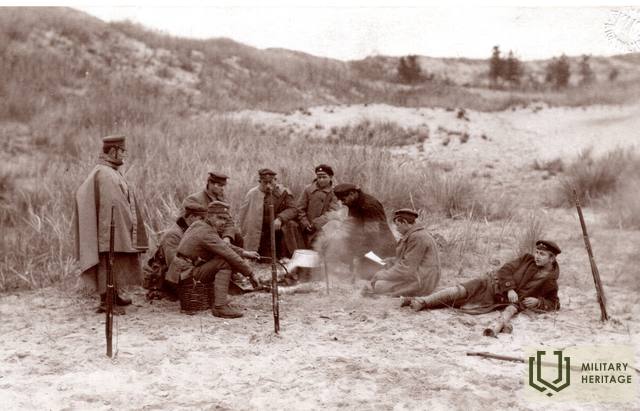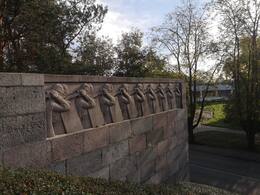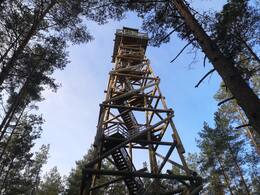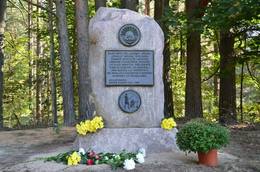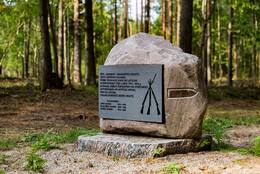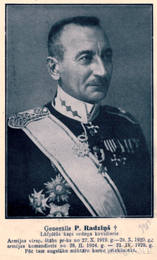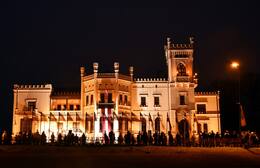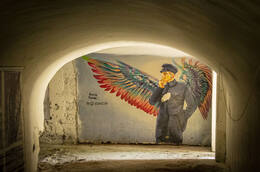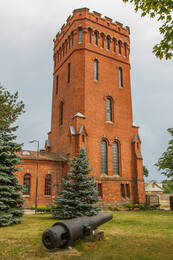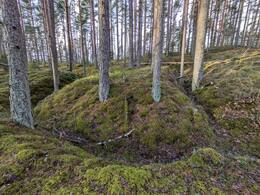Bermontia I Wars of Independence
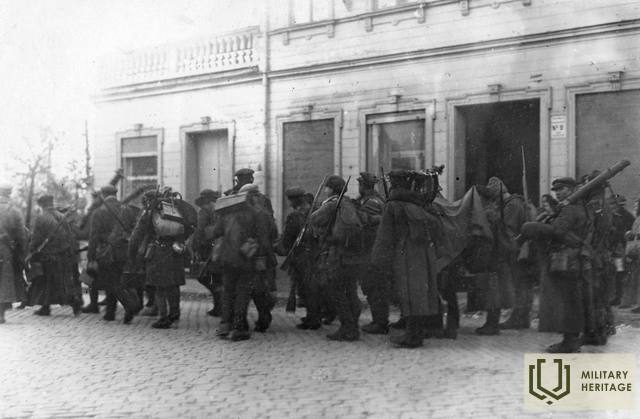
Bermontiad is part of the Latvian freedom struggle, in which the Latvian army, with the support of the Entente allies, from October 8, 1919 to December 3, 1919. It began with the attack of the Bermont army on Riga and ended with its defeat and expulsion from Latvia. The forces led by Pavel Bermont were better equipped and numerically larger, but the soldiers of the newly established Latvian army responded with vigor and patriotism.
The decisive turning point took place on November 10 and 11, 1919, when the Latvian Army liberated Pardaugava from the Bermontians and the soldiers of the Bermont Army (Western Russian Volunteer Army) retreated to Jelgava, the liberation of which on November 21 actually ended in Bermontia. Until the complete liberation of the territory of Latvia, heavy battles had to be fought, but Bermontia was one of the most significant turning points in the War of Independence of Latvia.
This was one of the bloodiest pages of the Latvian War of Independence (1918-1920) and at the same time a confirmation of the national will of the newly formed Latvian state, the first great victory of the Latvian Army as a unified independent unit. Bermontiad has a not only military significance in the history of Latvia, but also a sign of the heroism of the Latvian people. In the fierce battles, it was confirmed that the people of Latvia are able to fight for their own future. Most were united in the struggle not only for independence but also for the ideals of democracy, social and national justice. For Latvia, this victory meant the final liberation from German armed forces, as well as the opportunity to focus on the liberation of Latgale from Soviet Russia.
Pavel Bermont-Avalov (1877-1973) in this struggle was a symbol of everything the creators of the new Latvian state opposed. The self-proclaimed colonel cherished hopes for the restoration of the former Russian Empire, despising the right of small states to independence. In the revival of the collapsed empire, the new Latvian state of Bermont had exactly the same enemy as the Bolsheviks in Moscow.
Celebrating the liberation of Pārdaugava from the Bermontians, November 11 is now celebrated as Lāčplēsis Day, honoring the Latvian soldiers.
More information sources
Celvezi.lv. 2020. Bermontiad - an episode of the Latvian freedom struggle. Available: https://www.celvezi.lv/raksti/vesture/bermontiade/ [accessed 06.05.2021].
Related objects
Sudrabkalniņš hill - memorial for fight against Bermondt army
Located in Riga, Pardaugava, at the intersection of Sloka and Kurzeme Avenue.
At the beginning of November 1919, during the Latvian War of Independence, street battles between the Latvian Army and Bermont troops took place in Pardaugava. A decisive attack on the Bermont army took place in the area. In 1937, according to the project of Kārlis Zāle, a monument was unveiled in Sudrabkalniņa, honoring the fallen soldiers of the 6th Riga Infantry Regiment and highlighting the military features.
Designed as a memorial wall - a symbolic fortification, the gate of which depicts a lion blocking the path of an opponent's attack. Bricked from the stone blocks of the Daugavgrīva fortress protective wall and forged from the remaining granite of the Freedom Monument. The cost of the memorial site was almost 35,000 lats. For comparison, 4 “Ford - Vairogs V8 De Luxe” cars manufactured in Latvia could be purchased for such an amount.
Today you can see one of the most impressive places of remembrance of the War of Independence.
Bumbu hill firewatch tower
Latvian Freedom Struggle memorial site. During the Bermontiade in November 1919, the command post of the Latgale division led by Krišjānis Berķas was located here. 6. The Riga infantry regiment, attacking from Bumbu hill, captured Silver Hill.
A place of remembrance of the events of the Latvian War of Independence in Mārupe
It is located in the Mārupe region, on the side of the road between the Viesturi golf club and the Božu reservoir.
The memorial was opened in 2013. The history of the area is connected with the battle of the Latvian army against Bermont troops in 1919. Not far from Adainai's house, units of the Latvian army were stationed in combat positions.
During the War of Independence, due to the difficult situation, the Latvian government lacked the opportunity to supply the army with the necessary supplies. The appearance and armament of the soldiers varied. Most often, supply was based on the soldiers' ability to provide for themselves. At the end of September and beginning of October 1919, a Latvian military order came from Great Britain to eliminate the shortcomings. A month later, he also received a delivery of English armaments. With the first shipments, it was understood that Britain was getting rid of unnecessary stocks. Dirty, worn clothes and shoes, often too small, were also received. Soldiers wearing inappropriate footwear created health problems that affected combat capabilities. The garment was mended and re-stitched. The main unifying symbol was the 11-ray sun sign on the hat and a red-and-white armband around the left arm.
Today, several places of remembrance can be seen here. The facilities are part of a scenic, specially designed history and nature hiking route.
Guide Miķelis Yakunovs, +371 28353679.
The second monument to the soldiers of the first independent Latvia in Marupe
is located in Mārupe district, before the building of the golf club "Viesturi" on the forest road, opposite the sign to the golf training ground.
The authors of the project idea are Miķelis Jakunovs, Mārupe region guide, and Visvaldis Dumpis, the owner of the plot of land "Dumpmaļi".
In November 2014, during the week of Latvian patriots, in honor of Latvian soldiers, a second monument to Latvian soldiers was unveiled in the forest near Dzilnupīte, on the border of Mārupe and Babīte counties, in one of the battle sites of the First World War. The conceptual author and financier of the monuments is Visvaldis Dumpis, they were created by sculptor Ivars Feldbergs. The owner of the memorial, Visvaldis Dumpis, would like people to gather here not only on June 14 and March 25, but also on July 10, the anniversary of the founding of the national defense forces, and other important historical events for Latvians.
On November 9, 2018, an informative stand about the history of the place and attractions was opened near the monument. It is dedicated to the history of the place, telling about the "Adieņi" houses that once existed here and the Ķurbja family living there, the events of the First World War in the area, as well as the historical objects that can no longer be seen in nature - Dūči Bridge, Dzirnava Pond and Mill, Hunting Baths.
Memorial place of General Pēteris Radziņš
Located in Valka parish, driving on the road Valka - Rūjiena (P22) 4 kilometers, to the right, following the signs.
Pēteris Radziņš was born on May 2, 1880 in Lugavis Parish, Jaunvīndedze. Studied at Lugaži Parish School, Valka City School and Valka Nelson Real School. Joined the Russian army as a volunteer. In the autumn of 1919, he returned to Latvia and on October 27 was appointed Chief of Staff of the Commander-in-Chief of the Army, assuming this position at a time when the Bermontians were threatening Riga. As the chief of staff, he has led all the battles of Riga, Zemgale and Latgale. Promoted to General on February 5, 1920.
Today, a memorial stone dedicated to General Pēteris Radziņš (1880 - 1930) can be seen near the family house.
On November 11, 2017, a memorial plaque to Pēteris Radziņš was unveiled in Riga, at the corner of the Daugava gate.
Video: Memorial event of General P. Radziņš in Riga Brothers Cemetery in 2019
Video: On May 2, 2019, on the 139th birthday of General Pēteris Radziņš, a commemoration event took place on the embankment of November 11, near the Presidential Palace, covering the memorial plaque to the guard of honor and those interested.
The exposition of Valka Local History Museum “Valka - the cradle of Latvia's independence” also reflects the life and work of General Pēteris Radziņš.
In addition to the traditional ways of displaying the collection, the exhibition uses interactive multimedia solutions. Information and annotations translated into Estonian and English.
Alūksne Museum
The Alūksne Museum is located in an architectural monument of national significance: the neo-Gothic Alūksne New Castle built in the late 19th century. The museum features an exhibition named ‘Memorial Room for Victims of the Totalitarian Regime’, which tells about the fate of the inhabitants of Alūksne municipality in Siberia and the Far East, while the time periods from prehistory to the present meet in the Alūksne history exhibit ‘Feast of the Ages’. It features a separate section devoted to the contribution of the 7th Sigulda Infantry Regiment to the military, culture and public life. The formation of the 7th Sigulda Infantry Regiment began on 20 June 1919 in the Naukšēni Manor. Initially, a battle group of 22 officers and 1,580 soldiers was formed from the reserve battalion of the Northern Latvian Brigade, and was named the Dankers Division. It was included in the 2nd Battalion of the 3rd Jelgava Regiment. On 23 August, following an increase in the number of companies, it became part of the 7th Sigulda Infantry Regiment. Having taken part in the battles against Bermondt, on 5 January 1920, the regiment was transferred to the Latgale front to fight the Bolsheviks. After the signing of the Peace Treaty with Soviet Russia, the regiment guarded Latvia’s eastern border. The Latvian War of Independence saw the deaths of more than 200 soldiers of the regiment, while 85 were awarded the Lāčplēsis War Order. In 1921, the 7th Sigulda Infantry Regiment was stationed in Alūksne. The regiment’s headquarters were set up in the Alūksne New Castle. After World War II, the castle was taken over by Soviet security institutions. As of the late 1950s, the castle housed various cultural institutions: the Culture and Cinematography Department of the Executive Committee, a pioneer house, a library, a cinema and a museum.
Liepāja Northern Fort and Battery Nr.1 in Karosta
The Northern Forts are the best known and visually most impressive part of the Liepāja Fortress. Built by the Russian tsarist army in the late 19th century, their historical name is Fortress Battery No 1.
In November 1908, less than 10 years after its construction, the Liepāja Fortress ceased to operate, because its construction was acknowledged as a strategic mistake. Some of the cannons were dismantled and taken to the Kaunas Fortress in Lithuania, while others were remelted. Fortification structures were detonated twice in an attempt to destroy the fortifications. Elements surviving to the present day include artillery batteries not fully destroyed in the explosions and underground structures. Just like the Karosta, the Northern Forts were a closed military territory during the Soviet occupation. Visitors to the Northern Forts should be very careful. As in other places on the Latvian coast, the steep shore of the Baltic Sea in the Karosta is dangerous due to potential coastal landslides. Therefore, it is not allowed to walk under the ruins of the forts.
In the northern part of the fortress was located one of the four coastal defence batteries, Battery No.1. The battery was to house six 6-inch (152 mm) guns of the 1892 model of the Canet system, six 11-inch (280 mm) guns of the 1887 model and two 57 mm Nordenfeld anti-ship guns. Only the guns of the Canet system had a long enough firing range to withstand possible shelling by the German Navy. Thus, at the time of the liquidation of the fortress, the armament was only partially installed.
The Redan, Karosta
Redans, or Redana Fort, is located in Karosta, 14. novembra Street, about 1.5 km from the Northern Forts, in the nature reserve "Tosmare".
Historically, redans were elements of fortifications where longer sections of fortress walls were divided into shorter sections by building V-shaped positions facing the enemy, which allowed for better protection of the fortification wall. Karostas Redan is a late 19th century Liepaja Sea Fortress, projecting towards Lake Tosmare. As the fortress lost its fortress role, the fortifications and forts around it were partially blown up and rendered unusable. However, Redan remained almost intact.
In November 1919, after the failure at Riga, Pavel-Bermont Avalov's forces launched an intensive attack on Liepaja. The battle was also fought at Redan, where 80 soldiers of the Liepaja Military Port Commandant's Office under the command of Lieutenant Commander Radzins fought. In a swift attack on 14 November, the Bermontians managed to take Redan. This was followed by a counter-attack by Latvian troops and Redan was retaken.
In June, July and August, a knowledgeable guide will be waiting at Redan every day from 11.00-17.00, ready to tell you more about Liepāja Fortress and the historical events in the Karosta.
Karosta Water Tower
The water tower is located in Liepaja, in the Karosta, at 29 General Baloža Street - where the street meets Lazaretes Street. The water tower was an important building in the Karosta, as it supplied almost the entire Karosta area with drinking water. The exact time of construction of the water tower is unknown, but it could have been between 1903 and 1905. The project was probably designed by the St Petersburg architect Stefan Galenzovsky.
The water tower was powered by a steam engine with two coal boilers, one of which was kept in reserve, so there is an equally tall chimney next to the tower. The transmission powered four pumps, two of which were kept in reserve. Four boreholes supplied water to the pumps, which pumped it to a reservoir on the fifth floor of the tower and from there to the officers' apartments and soldiers' barracks in the Karosta.
When the Latvian Army took over the management of the water tower, the Ministry of War also took over the management of the water tower. After the Second World War, the Soviet Army took over the management. The water tower has been closed since 1989.
Although the tower was not a military building, in November 1919 the Latvian Army corrected the artillery fire of the British warships in the fight against the attack of the Bermont troops.
https://industrialheritage.travel/lv/objects/karostas-udenstornis/51
Nordeķi – Kalnciemas dune ridge
The approximately 30 km long dune ridge, which can be traced in nature from Iļģuciems (with minor interruptions) to Tīreļi today, is one of the most impressive landforms of the Seaside Lowlands, which is rarely perceived as a single natural formation. The dune was formed on the shores of one of the last Baltic glacial lakes, as the waters of the Baltic glacial lake receded. The dune ridge consists of two parallel 50–100 m wide dune belts. They are usually 6–10 m high, but their highest points reach 16–19 m above sea level. In the vicinity of Kleisti, Imanta and Beberbeķi, the beautiful pine forests covering the dunes are a popular place for walking, recreation and sports, and in winter - cross-country skiing. The part of the dune in the vicinity of Lāčupīte is associated with the events of the Bermontiades. On the dune in Pārdaugava is the Lāčupe or Lācaras cemetery . Between Pinkie and Babīte, the Beberbeķi Nature Park has been established to preserve the dunes. The western part of the Nordeķi-Kalnciemas dune ridge, approximately 10 km long, is called the Long Dune . Near the Long Dune (south of Trenči) is the Antiņi Brothers Cemetery , the Latvian Riflemen's Hospital medicine warehouse , and the renovated Latvian Riflemen's dugouts . South of the Long Dune is a massif of swampy forests and marshes, including Rāvājs and Maztīrelis . Opposite Maztīrelis is Ložmetējkalns with a viewing tower and a resting place and the so-called German rampart section . Even further west, near the Long Dune are the Latvian Riflemen Brothers Cemetery and the Piķi Brothers Cemetery. With greater or lesser interruptions, trenches are visible almost along the entire Nordeķi-Kalnciemas dune ridge. In the southwestern part of the Long Dune – in the swampy forests that adjoin it from the south, bomb craters from the First World War are visible. Along the entire length of the Long Dune (south of it), small forest paths run, suitable for walks and longer hikes – a great opportunity to explore the sites of the First World War battles.
Related stories
For the first Commander-in-Chief of the Latvian Army David Simanson
The essays of the book "Latvian Army Commanders" convince that history is significantly influenced by specific people. Although at the epicenter of the most important historical events for a short time, the true Latvian patriots, with their rich military experience, managed to accomplish a lot in the formation and strengthening of the Latvian army and the turn of historical events.
This story is about the first commander-in-chief of the Latvian army, David Simanson (1859-1933).
Awarding of the 7th Sigulda Infantry Regiment in bermontiad, awarding of the great soldier Valija Veščūnas with the Lāčplēsis War Order in Alūksne
After the Latvian War of Independence, the great soldier Valija Veščunas was awarded the Lāčplēsis War Order for the November 19, 1919 battles with the Bermontians at the Plan House. Valija Veshchun was one of the first to cross the Lielupe under the fire of the enemy.
In memory of Pēteris Radziņš, General of the Latvian Army, two-time Knight of the Lāčplēsis War Order
General Pēteris Radziņš, born in Lugka Parish, Valka District, in a simple farmer's family, where he learned to do field work. He was a very smart young man, after graduating from school he decided in favor of the war and it started his army rescue of Latvia from Bermont's troops. P.Radziņš was one of the most outstanding officers of the Latvian Army and was awarded with numerous Latvian and foreign orders and memorials.
Memories of the beginning of the establishment of the War Museum
The narrator describes the conditions under which the War Museum was established. Problems and collection work are mentioned.
Kārlis Zāle and the Freedom Monument
The narrator describes Kārlis Zali as a personality who created the most famous works of Latvian art. The description is dedicated to the commemoration of the hall in 1942 (the year of K. Hall's death). The memories have been chosen to describe K. Zāle's works based on the author's personal qualities and perception of the world.
Par Sudrabkalniņa atklāšanas svētkiem
Atmiņu stāsta izvilkums no ģenerāļa Jāņa Baloža uzrunas Sudrabkalniņa pieminekļa atklāšanas dienā. Pilnā tekstā ir atstāsts par atklāšanas pasākuma norisi, Valsts prezidenta Kārļa Ulmaņa un ģenerāļa Jāņa Baloža uzrunas. Atmiņas izvēlētas, jo spilgti parāda to kādā stāvoklī bija Latvijas armija, kura cīnās Sudrabkalniņa apkaimē.
Bomb Hill
Bumbu Hill is a high hill in the Bolderāja dunes, Kleistu Forest, Rīga. Memorial to the Latvian Freedom Fights. During the Bermontiad in November 1919, the command post of the Latgale Division led by Krišjānis Berkis was located here. The 6th Riga Infantry Regiment, attacking from Bumbu Hill, captured Sudrabkalniņa. A memorial plaque was erected in 1939 and destroyed in 1969. The memorial site was restored in 1989.
Latvian Army armored train No.5 or "Kalpaks"
Latvian Army Armoured Train No.5 or "Kalpaks" was a light armoured train in the Latvian Armed Forces in 1919.
Reasons for awarding the award to Commander of the Armoured Train A.Klestrov
After successfully repelling an enemy attack, the commander of the armed train A.Klestrov falls and Colonel Danker issued the grounds for the award
How the men of the Latvian government fooled the co-runners of the Pampali Bolsheviks
The former director of the Pampāli school (until 1959) Alfred Brūns has hand-printed an impressive book about the history of the Pampāli school and historical events around it with authentic photographs. In the book, A. Brūns describes the events of the War of Independence in Pampāli, describing in detail the events involved both Latvian statesmen, Bolshevik supporters, actions of the German army, etc.
The story of a unique military object in Karosta
For years, I have not noticed any sustained interest in the unique places just eight to ten kilometres north of the city centre among the residents of Old Liepaja. But hidden in the thicket of the forest, on the dune bank or on the marsh paths, the historic sites of the Karosta are no less interesting historical facts and stories worthy of long-forgotten legends. One of them - the former 23rd Coastal Artillery Battery of the USSR - will be the subject of this story.
Description of the combat activity of Vilis Narkevics on 6 November 1919
Description of the combat activity of the commander of the detachment, Lieutenant Commander Julius Rosenthal Vilis Narkevics, 3 November 1921




